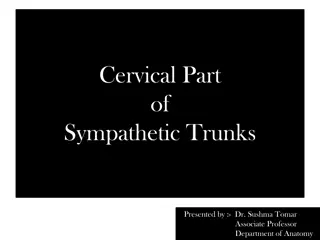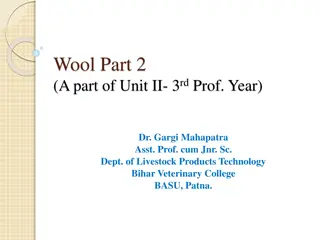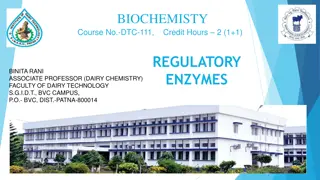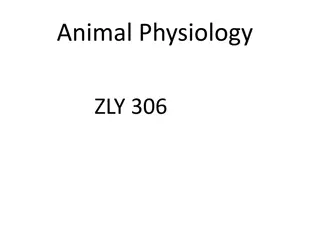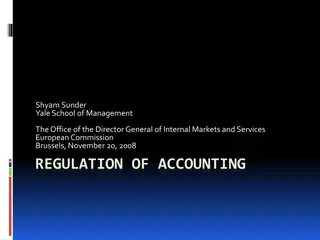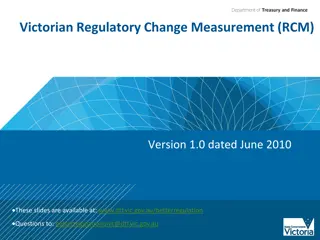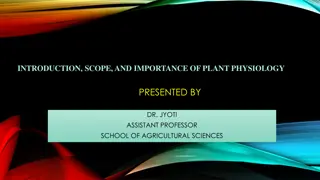Understanding the Physiology of Basal Ganglia and Regulatory Mechanisms
This lecture covers the physiology of basal ganglia, including the different nuclei, pathways, and neurotransmitters involved. It explains the functions of caudate and putamen circuits, integration of direct and indirect pathways, and diagnosis of basal ganglia disorders. The connections and basic circuits of basal ganglia are detailed, shedding light on motor, cognitive, limbic, and ocular loops. Metabolic characteristics of basal ganglia are also discussed, such as high oxygen consumption and concerns like Wilson's disease.
Download Presentation

Please find below an Image/Link to download the presentation.
The content on the website is provided AS IS for your information and personal use only. It may not be sold, licensed, or shared on other websites without obtaining consent from the author. Download presentation by click this link. If you encounter any issues during the download, it is possible that the publisher has removed the file from their server.
E N D
Presentation Transcript
PHYSIOLOGY OF BASAL GANGLIA AND REGULATORY MECHANISMS Dr Syed Shahid Habib MBBS DSDM FCPS Professor Dept. of Physiology King Saud University
OBJECTIVES At the end of this lecture the students At the end of this lecture the students should be able to: should be able to:- - Enumarate different nuclei of basal ganglia Know different pathways (loops) and neurotransmitters involved in basal ganglia functions Explain functions of Caudate & Putamen circuits of basal ganglia Integration of direct and Indirect Pathways Diagnose basal ganglia disorders
Cerebral Cortex CEREBRAL CORTEX Cerebral Cortex BASAL GANGLIA Corticospinal tracts THALAMIUS Corticobulbar tracts CEREBELLUM BRAIN STEM Bulbospinal tracts SENSORY INPUT SPINAL CORD FINAL COMMON PATH
3 Connections to remember 1. Main input to the basal ganglia 2. Main output from the basal ganglia 3. Connections between parts of basal ganglia Basal Nuclei Caudate Nucleus Corpus Striatum Putamen Lentiform Globus Pallidus Subthalamic Nucleus Substantia Nigra
BASIC CIRCUITS OF BASAL GANGLIA 1. Motor loop (putamen circuit) concerned with execution of learned movement subconciosly. 2. Cognitive loop (Caudate circuit) concerned with cognitive control of sequences of motor pattern. Basically it is concerned with motor intentions. (Note: cognition means thinking process using sensory input with information already stored in memory.) 3. Limbic loop involved in giving motor expression to emotions like, smiling, aggressive or submissive posture. 4. Occulomotor loop concerned with voluntary eye movement [ saccadic movement] 5
The Putamen Circuit Prim Motor Cortex Premotor Suppl Motor Areas Premotor Suppl Motor Somatosensory Cortex
The Caudate Circuit Prefrontal Premotor Suppl Motor Association Areas
Metabolic characteristics of BG High Oxygen consumption . High Copper content in Wilson s disease (Copper intoxication): Autosomal Recessive Copper binding protein Ceruloplasmin is low Lenticular degeneration occurs
BASAL GANGLIA FUNCTIONS Control of movements Planning and programming of movements Cognition
The Putamen Circuit Executes Learned Patterns of Motor Activity Basal ganglia function in association with the corticospinal system to control complex patterns of motor activity. Examples are: writing of letters of the alphabet. cutting paper with scissors, hammering nails, shooting a basketball through a hoop, passing a football, throwing a baseball, the movements of shoveling dirt, most aspects of vocalization, controlled movements of the eyes virtually any other of our skilled movements, most of them performed subconsciously.
The Caudate Circuit Cognitive Control of Sequences of Motor Patterns Cognition means the thinking processes of the brain, using both sensory input to the brain plus information already stored in memory. Thoughts are generated in the mind by a process called cognitive control of motor activity. Example:A person seeing a lion approach and then responding instantaneously and automatically by (1) turning away from the lion, (2) beginning to run, and (3) even attempting to climb a tree. Thus, cognitive control of motor activity determines subconsciously, and within seconds, which patterns of movement will be used together to achieve a complex goal
The Caudate Circuit Change the Timing and to Scale the Intensity of Movements Two important capabilities of the brain in controlling movement are (1) to determine how rapidly the movement is to be performed and (2) to control how large the movement will be. For instance, a person may write the letter "a" slowly or rapidly. Also, he or she may write a small "a" on a piece of paper or a large "a" on a chalkboard. Regardless of the choice, the proportional characteristics of the letter remain nearly the same
Basal Ganglial Pathways Direct and Indirect
MOTOR ACTIVITY Both Direct & Indirect Basal Ganglial Pathway MOTOR ACTIVITY Direct GPe Striatum GPi Thalamus SThN SNPC
Direct Basal Ganglial Pathway Stimulation leads to Motor Activity MOTOR ACTIVITY + GLU GLU + GPe + - DA1+ GABA St GPi - Thalamus GABA - DA2 - Thalamocortical Neurons are disinhibited SThN SNPC
MOTOR ACTIVITY Indirect Basal Ganglial Pathway Stimulation leads to Motor Activity + GLU + GLU GPe - GABA St GPi GABA - Thalamus - + DA1+ DA2 - GABA + GLU Subthalamic Neurons are disinhibited - SThN SNPC
MOTOR ACTIVITY Both Direct & Indirect Basal Ganglial Pathway MOTOR ACTIVITY + + GLU GLU GLU + - GABA GPe - GLU GABA + St GPi GABA - - Thalamus - GABA DA1 + + GLU DA2 - - GABA SThN SNPC
Movement Disorders Hypokinetic Hyperkinetic Hemiballismus Huntington s Disease Athetosis Parkinson s Disease Drug Induced (Neuroleptics, MPTP)
Movement Disorder Chorea Features Lesion Multiole quick, random movements, usually most prominent in the appendicular muscles Slow writhing movements,which are usually more severe in the appendicular muscles Wild flinging movements of half of the body Atrophy of the striatum. Huntington Chorea Athetosis Diffuse hypermyelination of corpus striatum and thalamus Hemiballismus Hemorrhagic destruction of contralateral subthalamic n. Hypertensive patients Degenration of Substantia Nigra Parkinsonism Pill rolling tremor of the fingers at rest, lead pipe rigidity and akinesia
Parkinsons Disease Described by James Parkinson Degeneration of dopaminergic nigrostriatal neurons (60-80 %). Phenthiazines (tranquilizers drugs) . Methyl-Phenyl-Tetrahydro-Pyridine (MPTP). The oxidant MPP+ is toxic to SN. Five cardinal features Tremor Rigidity Akinesia & Bradykinesia Postural Changes Speech Changes evolution
MOTOR Both Direct & Indirect Basal Ganglial Pathway MOTOR + + GLU + - GABA GPe - GABA GLU + P GPi GABA - - Thalamus - GABA DA1 + + GLU DA2 - - GABA SThN SNPC



